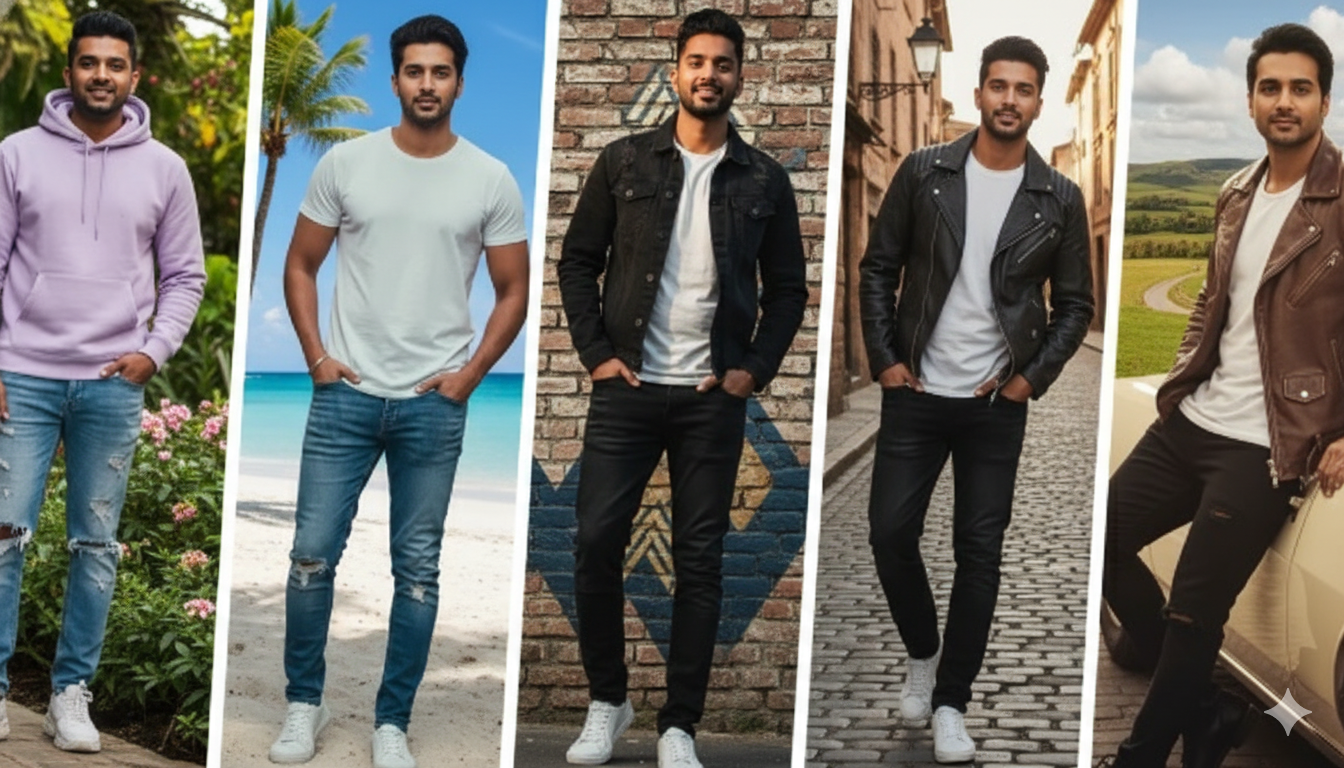Use these prompts to guide the AI model on the exact style, color, and texture you want applied to a portrait to achieve a high-fashion or blockbuster cinematic look.
In-article:
I. Cinematic Lighting and Atmosphere
These prompts focus on dramatic light, contrast, and filmic elements common in movies and high-end editorials.
- High-Contrast Film Noir Edit: Apply extreme chiaroscuro lighting, with hard, deep black shadows and bright, stylized highlights (rim light). Add a subtle layer of 35mm film grain and a vintage sepia tint.
- Blockbuster Teal and Orange Grade: Process the image with the classic Teal and Orange color grading scheme. Shadows should be deep cyan/teal, and highlights/skin tones should be warm orange. Use a wide-angle lens distortion effect.
- Cyberpunk Neon Rim Light: Retouch the image to appear taken in a rainy, futuristic cityscape. Add strong blue and magenta neon rim lighting reflecting off wet surfaces. Increase saturation on the lights only; keep the rest of the image dark.
- Soft Golden Hour Backlit Portrait: Apply a dreamy, diffused golden hour glow to the background and subject’s hair. Use a very shallow depth of field (bokeh) with a pronounced, stylized lens flare.
- Moody Low-Key Smoke Study: Convert the image to black and white, but maintain deep, crushed blacks and high contrast. Add a layer of atmospheric fog or smoke visible only in the highlights, giving it a dramatic, mysterious edge.
II. Fashion, Texture, and Material Focus
These prompts emphasize material textures, clean lines, and the polished look of magazine photography.
- Gritty 90s Streetwear Editorial: Apply a very strong, visible analog film grain (like Kodachrome 64) with slightly elevated blacks and a faded color palette. Enhance the texture of denim or concrete in the background.
- Sleek Monochromatic High-Fashion: Convert to a highly refined black and white. Use extremely high detail sharpness, especially on fabric texture and facial features. The output must look like a clean, high-cost studio print.
- Vaporwave Synthwave Retouch: Color grade the image with a dominant palette of electric magenta, cyan, and deep violet. Apply a subtle, horizontal scan-line VHS filter effect for a retro-futuristic aesthetic.
- Rustic, Vintage Leather Texture: Focus the lighting to enhance the texture of thick wool or worn leather. Use warm, earthy color tones (deep browns, burnt siennas) and a soft vignette.
- Matte Look Magazine Cover: Apply a flat, matte color finish to reduce all gloss and reflectivity. Use a symmetrical composition with minimal, highly saturated color elements, mimicking a stylized, graphic design approach.
III. Dynamic Action and Environment
These focus on integrating the subject into a dynamic setting, often requiring background modifications or effects.
- Paparazzi Flash Motion Blur: Create the appearance of a candid moment caught by a flash. The subject should be sharply lit in the foreground, while the background must have exaggerated, directional motion blur to imply fast movement.
- Urban Explorer Rooftop Perspective: Apply a wide-angle fisheye distortion filter to exaggerate the sense of height and perspective. Use cool, hazy blues and grays for the cityscape background.
- Rainy Window Reflection Overlay: Add a realistic rainy window glass overlay effect across the image, with streaks and droplets. The lighting should come from blurred, distant city lights (bokeh) reflecting off the water.
- Cinematic Slow-Shutter Panning: Apply a horizontal speed blur to the entire background and non-essential parts of the subject, keeping the subject’s face sharp and in focus, emphasizing speed and dynamism.
- Desert Traveler Sun Bleached Grade: Desaturate the colors severely and lift the black point to simulate a sun-bleached, dusty look. Add a fine layer of digital dust and light leaks.
IV. Unique Color Palettes and Artistic Filters
These prompts aim for specific, non-traditional color palettes or highly stylized digital effects.
- Muted Sage Green and Ochre Tones: Apply a unique, soft color grade dominated by muted sage greens, pale yellows, and ochre. The overall feeling should be calm, natural, and slightly subdued.
- Hyper-Realism Digital Painting Conversion: Convert the photo into a highly detailed digital oil painting. The brush strokes should be visible and stylized, with slightly exaggerated colors and perfect skin smoothing.
- Japanese Cinema (Wong Kar-wai) Grade: Apply a strong filter of deep reds, vibrant greens, and hazy yellows. The lighting should be dark, moody, and intentionally blurry in the background, focusing on saturated color pools.
- Crushed Blacks and Retro Color Pop: Deeply crush the black levels until shadow details are almost entirely lost. Simultaneously, make one or two colors (like red or turquoise) pop with extreme, almost unrealistic saturation.
- Arctic Cold Steel Look: Shift the entire color balance to be predominantly cold blue and icy white. Add a layer of crystalline sharpness and subtle vignetting to frame the subject as if they are in an extremely cold environment.
